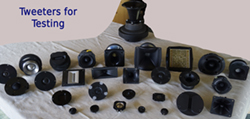Audio Pet Peeves
and Possible Solutions
to Make You Smile
Amp degrades or clips when it gets hot
An amp should be able to maintain optimal performance for an entire movie. Amps with similar specs can sound vastly different when they get hot or when they attempt to play louder passages.
Class D amps weigh less and cost less, so they are often chosen to keep costs down. However, though both Class D and Soaring amps may say they put out the same Watts, the listening experience will be vastly different. Just like having a V8 engine does not necessarily give you race car performance; having a 300 Watt amplifier does not necessarily give you the peak performance you desire.
Class D amps do not have temperature and power stability. Thus their performance will be disappointingly inconsistent over time.
The most obvious difference is weight - 3 pounds for Class D versus the Soaring amp 38 pounds. In a 7.1 installation you are looking at 30 pounds versus over 250 pounds. The additional weight comes mainly from the transformers and heatsinks. These, along with the 28 extra storage capacitors in each Soaring amp, give the ability to provide great dynamics and stability of sound over an entire movie.
We used a thermo-imaging camera to see the temperature over the entire amp. We then rearranged the parts to optimize for temperature consistency. Transistors put out more current when they are hot. If you have more than one transistor, you want them to be the same temperature so they share the work equally and give the best sonic results.
$10 tweeters
It is amazing how many expensive speakers cheap out on the tweeter. Tweeter frequencies provide the upper harmonics to everything - music, sound effects and speech. When they are mushy and non-articulating, it takes the fun out of listening. Then, as one of your favorite characters would say, everything goes from brilliant to boring.
With a poor tweeter, there is a resonate frequency that makes all cymbals sound alike and dull. With a good tweeter, you can discern the brushing on different cymbals and hear the jingling of keys. Trust your ears rather than the specs.
 Tweeters are notoriously difficult to measure. A great tweeter will often be better than the microphone being used to measure it. As with many things in the audio world, the tweeter can have good specifications, but not sound particularly good in the real world. It is highly likely that a well-publicized $10 tweeter will have better specs than the ribbon tweeter on the big Magnepan speakers. However, the Magnepan will leave it in the dust in terms of listening enjoyment.
Tweeters are notoriously difficult to measure. A great tweeter will often be better than the microphone being used to measure it. As with many things in the audio world, the tweeter can have good specifications, but not sound particularly good in the real world. It is highly likely that a well-publicized $10 tweeter will have better specs than the ribbon tweeter on the big Magnepan speakers. However, the Magnepan will leave it in the dust in terms of listening enjoyment.
Again, trust your ears rather than specs. Or you can trust Soaring Audio speakers. The Golden Ears uses a combination of sophisticated test equipment and actual listening to make speakers that are fun to listen to. We tested and listened to over 30 tweeters that had good enough specs to consider.
Fanatics only: Part of the measurement issues with tweeters is that different frequencies have different polar radiation patterns. This is a super complicated subject. You can Google it if you want - not that it will help...
One Note Bass - Car Stereos
I'm constantly reminded of this on going peeve. All you have to do is drive around town and sure enough, there is a poorly executed car stereo exhibiting this trait. I am sure it annoys everyone else around the car as much as it does me.
Woofer cabinets are like a musical instrument. Whether the sound waves originate from a vibrating string or a woofer, the cabinet reacts the same way. Just as poorly designed violins sound boring and unremarkable, so do speakers with no thought into the variables of the design. The cabinet, the speaker itself and the tuning of the system all greatly affect the final enjoyment.
To avoid one note bass in your car stereo, choose a woofer with large excursion. Xmax should be greater than 10. It also needs a Vas that is not too huge, say below 2 cubic feet. Build a cabinet very solid - at least 3/4" birch plywood or MDF, if you do not care about weight. If you are going for the loudest possible volume, port tune it to the resonant frequency of the system. The easiest way to tell without fancy equipment is to find the impedance peak with a volt meter and frequency generator. Then port the system to get two equal but lower peaks on each side of the original peak. Use a mini DSP board to EQ the system. After you have the speaker installed, try out various amplifiers at your favorite dealer. The sound will vary more than you can possibly imagine.
As a side note, I am not against loud car stereos. Crown made specialty amps for me in the 80's to exhibit at the North American Music Merchants (NAMM) show. Crown was introducing the pressure zone microphone (PZM) and wanted something to draw attention to the booth. I put the amps in a Honda Civic owned by a good friend who was willing to chop his new car up for a good cause. It had dual EV 18" woofers, 2" JBL bi-radial midrange, and JBL 2404 Baby Cheeks tweeters, tri-amplified in the back. There were JBL E110s with JBL 2402 bullet tweeters in the doors. It created an unwelcome sideshow for the whole trade show because people were lined up for aisle after aisle to be able to experience the thrill ride.
Because Crown never sold car amps, we had to return them after a year. We were so sad. But Crown introduced me to Dick Heyser, so I could get my beloved TEF20. It is the best speaker test device ever made and allowed me to prune and tune my speaker designs in ways that were not humanly possible.
Home theaters have even more problems with one note bass than car stereos. That will be covered soon.
Soaring Audio, Inc.
2900 Fantasy Lane
Sparks, NV 89441-8593
775-425-8000
sales@soaringaudio.com
